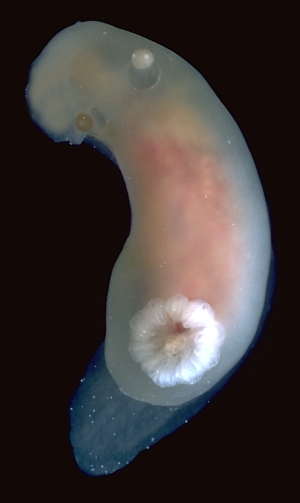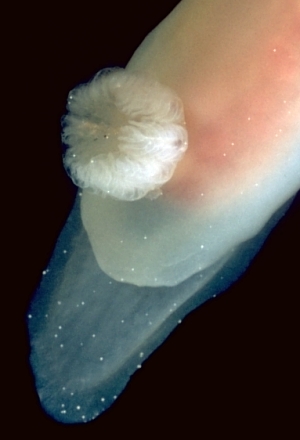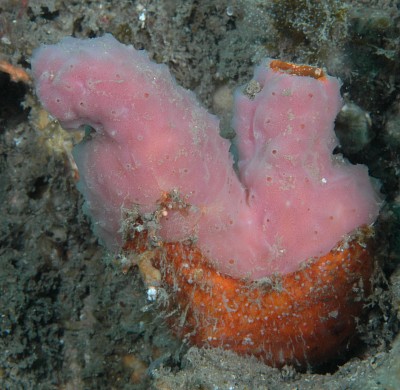
Hallaxa michaeli
Gosliner & Johnson, 1994
Order: NUDIBRANCHIA
Suborder: DORIDINA
Superfamily: EUDORIDOIDEA
Family: Actinocyclidae
DISTRIBUTION
Known only from south-eastern Australia [New South Wales, Victoria].
PHOTO
Barons Hut, Royal National Park, Sydney, March 1987, 20 m – on blue & white cunjevoi (Pyura sp), nudibranch 23 mm long. AM C152940. Photo: Bill Rudman
Elongate dorid, translucent white all over, with small opaque white specks scattered irregularly over the foot and mantle, and sometimes on the gills and rhinophores. The rhinophoree club has an opaque white tip. The bipinnate gills are typical for the genus, standing upright and forming a goblet shaped circlet around the anus in the posterior dorsal midline. Known from very few records. Both specimens from New South Wales have a pickish tinge showing through from the digestive gland. The colour is most probably associated with its food [see message #15628 ], the pink sponge Halisarca laxus (Lendenfeld).
See message #17208 for description of the radula.
-
Gosliner, T. M. & S. Johnson (1994) Review of the genus Hallaxa (Nudibranchia: Actinocyclidae) with descriptions of nine new species. The Veliger, 37(2): 155-191.


Rudman, W.B., 2006 (July 23) Hallaxa michaeli Gosliner & Johnson, 1994. [In] Sea Slug Forum. Australian Museum, Sydney. Available from http://www.seaslugforum.net/find/hallmich
Related messages
Re: Hallaxa michaeli on food sponge
September 14, 2009
From: Leanne and David Atkinson

Dear Bill,
To answer your questions about ascidians in our previous message [#22626]. We found the Hallaxa michaeli on sponge on an ascidian. This ascidian is often at the base of the stalked ascidians. There weren't any stalked ascidians in the immediate vicinity but there are plenty in the general area. We dive here at high tide to take advantage of the slack water. There is a very strong current that moves through the area with changing tides and we have witnessed nudibranchs launch themselves or lose their grip and be swept away by the current on occasions. It would be possible for them to have travelled to this ascidian from a stalked one. We have included photos of ascidians from the general area. The middle photos are of the type of ascidian we found them on. They were on the upper surface of the longer arm of the v shape you can see in profile. It was hard to get a photo without having part of the other arm of the v in it so they would be quite well protected in this spot. The lower photo is a single stalked ascidian with one of these at the base. The upper photo is of a group of the stalked ascidians with another one of these at the base we think, it is a bit overgrown and we are not confident of our knowledge about these particular ascidians.
Locality: Halifax Sponge Gardens, Port Stephens-Great Lakes Marine Park, Port Stephens, 10 to 12 metres, Pacific Ocean, 06 September 2009, Sandy bottom with some rocky reef with scattered sponges, ascidians, bryozoans and gorgonians. Length: 160 mm to 300 mm. Photographer: Leanne and David Atkinson.
Hope this answers your questions thank you for your help with our questions.
Best wishes,
Leanne & David Atkinson
atk@hunterlink.net.au



Dear Leanne and David,
Thanks for the information. It certainly looks as though the Hallaxa is not interested in the ascidians for their sake, but because they are the preferred 'home' of the sponge it feeds on. Like you, I am not an expert on ascidians so I can't really say if the unstalked ascidians are a growth stage or form of the stalked ones, but I am sure that observations like this will be useful in the future for anyone studying, not just the local nudibranchs, but also the sponges and the ascidians.
Best wishes,
Bill Rudman
Re: Hallaxa michaeli on food sponge
August 31, 2009
From: Leanne and David Atkinson

Concerning message #19734:
Hi Bill,
We are glad to see you are able to post messages again. Hope you get some technical support soon. We came across these nudibranchs we haven't seen before. The first thing we noticed were the little white egg spirals on an ascidian. We looked closer to see if we could find a nudibranch and found this pair of transparent nudibranchs with one of the spirals.Not sure if one of them is laying these eggs or merely moving over them. The closest we could find to it was Hallaxa michaeli. Are we correct in our identification? Thanks for your help.
Locality: Halifax Sponge Gardens, Port Stephens-Great Lakes Marine Park, Port Stephens, 15 metres, New South Wales, Australia, Pacific Ocean, 15 August 2009, Sandy bottom with scattered sponges, bryozoans, ascidians, soft corals and gorgonias. Length: 10 mm. Photographer: Leanne and David Atkinson.
Best wishes,
Leanne & David Atkinson
atk@hunterlink.net.au



Dear Leanne and David,
Yes this is Hallaxa michaeli. One characteristic of species of Hallaxa (and Actinocyclus) is the shape of gill circlet which is arranged in a goblet-like shape. It is a fool-proof way of identifying the genus. The sponge your animals are on is almost certainly the sponge Halisarca laxus, which is the only known food of H. michaeli. If we add the translucent whitish body I'd say you have ticked all the external character boxes.
You don't however mention the presence of stalked ascidians or cunjevoi. The sponge is considered to be found only in association with these stalked ascidians, and consequently Hallaxa has also only been found in association with them. That is not to say the sponge has read the rulebook, so if there were no stalked ascidians or cunjevoi around it would be interesting to know.
Best wishes,
Bill Rudman
Hallaxa michaeli on food sponge
March 23, 2007
From: Nicholas Missenden

Concerning message #17219:
Hi Bill,
Just thought I would send you some pictures that I took today of Hallaxa michaeli. I have taken pictures of them feeding on the yellow keratose sponges. As you can see from the full picture of the sponges there are a number of Hallaxa michaeli and their egg ribbons visible.
Locality: Bare Island, 22 m, NSW, Australia, Botany Bay, 21 March 2007, Sand bottom, broken reef . Length: from 10 mm to 20 mm. Photographer: Nicholas Missenden.
Regards
Nick
njmpm@iinet.net.au



Dear Nick,
Thanks for this great series of photos. It illustrates the close relationships these three species have to each other - Hallaxa michaeli feeding only on the sponge Halisarca laxus, and the sponge being found only on the stalked ascidian Pyura. For those of you not familar with Pyura, it is a stalked solitary ascidian, often found in groups or quite large beds. In Nick's photo the whole ascidian, stalk and body, are covered in a layer of sponge.
In your photo we can see the Hallaxa can burrow quite deeply into the sponge tissue, and its almost transparent mantle renders it almost invisible on its prey. In an earlier message [#17219] you mention finding Hallaxa on different coloured sponges. From you photo here it seems that the one colony of the sponge can range in colour through cream, brown, yellow and pink - which is new information on the sponge Halisarca laxus.
Best wishes,
Bill Rudman
Re: Hallaxa michaeli - feeding record
July 26, 2006
From: Nicholas Missenden
Concerning message #15628:
Hi Bill,
Thank you for your response to my identification problem for this nudibranch. I find that these nudibranchs are quite common once you know where to look for them. I have found them on all the different coloured sponges in this class, from the pink, yellow/off white and grey. If you would like me to make any more observations (ie: more feeding records / mating) on this particular species just let me know and I'll be happy to help.
Regards
Nick
njmpm@iinet.net.au
Missenden, N., 2006 (Jul 26) Re: Hallaxa michaeli - feeding record. [Message in] Sea Slug Forum. Australian Museum, Sydney. Available from http://www.seaslugforum.net/find/17219Dear Nick,
I would love to get some more information on this species, especially feeding, mating, colour variation etc. We know very little about this group of sponges as well, so photos, like your earlier one, showing us some detail on the sponge colonies as well would be great. As I mentioned before, there is a suggestion the sponge is found in association with stalked ascidians and cunjevoi, but I have no idea whether it is an obligatory relationship or whether the sponge can live quite happily away from the ascidians.
Best wishes,
Bill Rudman
Hallaxa michaeli - feeding record
July 24, 2006
From: Nicholas Missenden

Hi Bill,
Im hoping that you can help identify this nudibranch for me. It is very hard to spot on its food sponge. The eggs on the sponge caught my eye at first before finding this one. I removed it for a picture before placing it back.
Locality: Bare Island, La Perouse, Botany Bay, NSW, Australia. Depth: 12 m. Length: 20 mm. November 2005. Broken reef, sandy bottom. Photographer: Nicholas Missenden
Regards
Nick
njmpm@iinet.net.au
Missenden, N.J., 2006 (Jul 24) Hallaxa michaeli - feeding record. [Message in] Sea Slug Forum. Australian Museum, Sydney. Available from http://www.seaslugforum.net/find/15628
Dear Nick,
This is a very interesting find. I have found this animal a few times in New South Wales and it was named Hallaxa michaeli about 10 years ago. Little is known about it, the original description being based on one 6 mm long animal. Many species of Hallaxa appear to feed on keratose sponges of the genus Halisarca, so I was excited to see your animal on this pink sponge which is Halisarca laxus (Lendefeld), a species known only from New South Wales. The identity of that species remained a mystery for over 100 years until a living specimen was examined by Pat Bergquist, who published a photo of an almost identically shaped and coloured colony as the one in your photo (Bergquist,1996). Also Bergquist stated that the sponge seemed to grow commmensally on the ascidian Pyura. By coincidence, the specimen whose photos I am using for the species Fact Sheet, was found on cunjevoi, the local name here for a stalked ascidian of the genus Pyura.
I only wish all my attempts at finding feeding information fell into place so well.
- Bergquist, P.R. (1996) The marine fauna of New Zealand. Porifera: Demospongiae Part 5. Dendroceratida and Halisarcida. New Zealand Oceanographic Memoir, 107: 1-53.
Best wishes,
Bill Rudman
Hallaxa michaeli - radula photos
July 24, 2006
From: Bill Rudman


I am posting today a Fact Sheet on Hallaxa michaeli. Here are some electron micrographs of the radular teeth of the specimen illustrated on that Fact Sheet.
PHOTOS: Radular teeth and Jaw plates of H. michaeli. Barons Hut, Royal National Park, Sydney, March 1987, 20 m - on blue & white cunjevoi (ascidian), nudibranch 23 mm long. AM C152940. Upper photo: right side of radula showing 4 complete half rows. Scale bar = 100 µm. Middle photo: showing innermost tooth and inner laterals on right side. Scale bar = 10 µm. Lower photo: section of jawplate showing multi-tipped jaw rodlets.Scale bar = 10 µm. SEM Photos: Geoff Avern.
Rudman, W.B., 2006 (Jul 24) Hallaxa michaeli - radula photos. [Message in] Sea Slug Forum. Australian Museum, Sydney. Available from http://www.seaslugforum.net/find/17208
The family Actinocyclidae has interesting similarities in a number of anatomical features to the Chromodorididae and many workers consider the two families to have a common origin. One of the similarities is the morphology of the buccal armature, and if we exclude the innermost lateral tooth, both the radula and jaw plates, as illustrated here, could well belong to some species of the chromodorid genus Noumea.
Best wishes,
Bill Rudman
